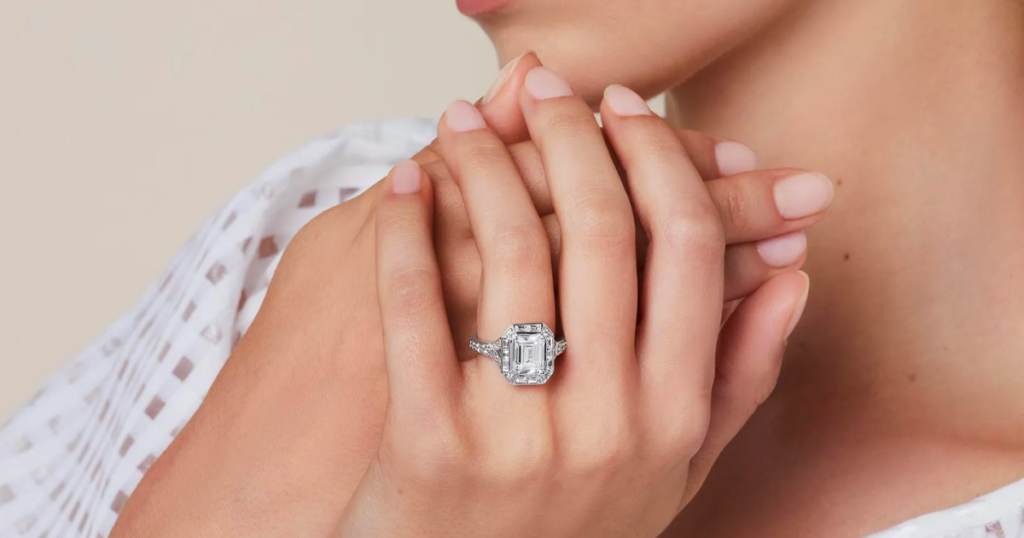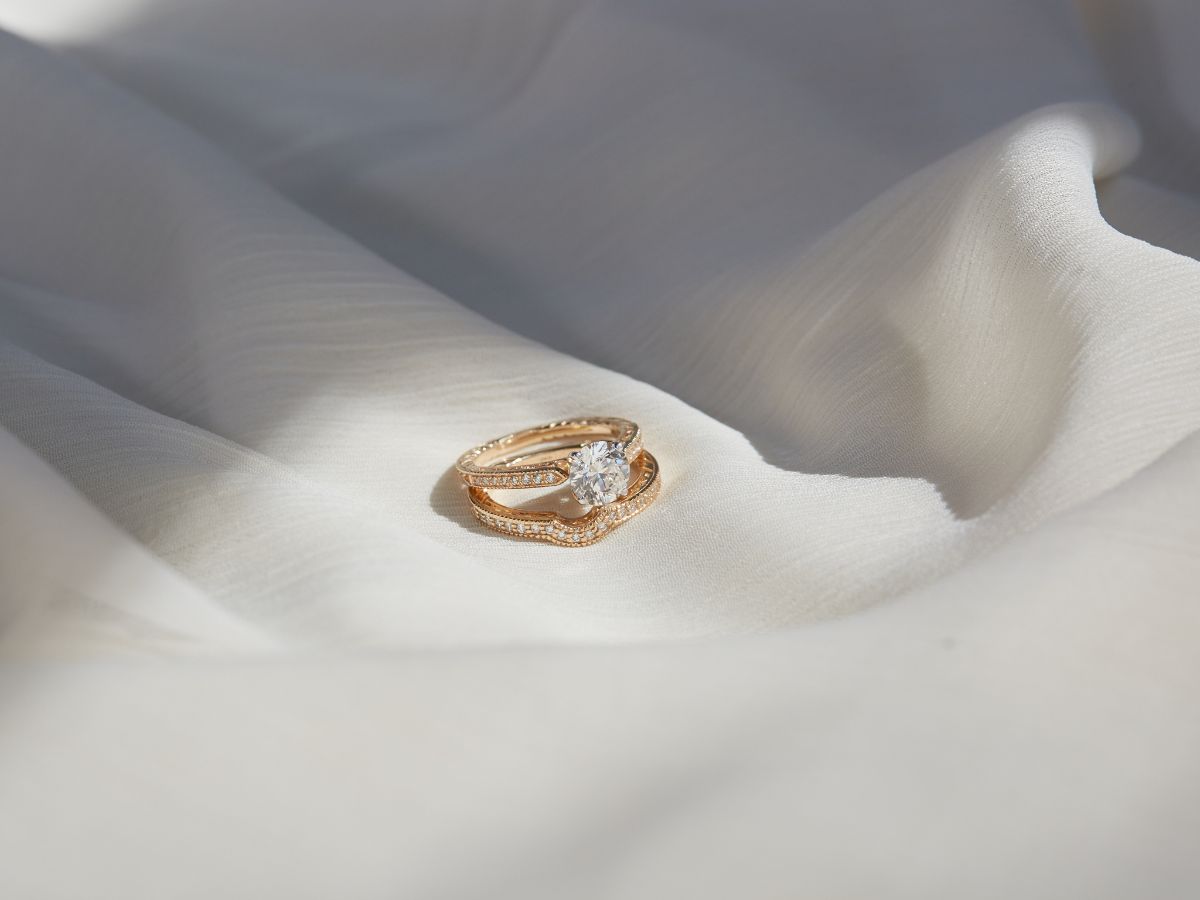Not many people know the history of wedding rings. Up there, with the white dress and the bouquet, the wedding ring may be the most universally recognizable symbol of marriage. But unlike wilting flowers and yellowing dresses, wedding rings last forever.
In fact, many wedding rings are passed down through family lines, becoming heirlooms of priceless significance. Contained in each ring lives the hopes and stories of those that came before. And as such, personal and family history are intimately tied to wedding rings.
But what about the history of wedding rings themselves?
Where did the exchange of wedding rings originate? What is the symbolism and significance of the custom? Why do we wear the rings the way we do? And, how is the tradition continuing to evolve today?
Let’s take a look.
History of Wedding Rings

Ancient Origins
Wedding ring history starts a bit further back than you might expect — in the same part of the world that is often credited with originating human civilization.
There is archaeological evidence to suggest that ancient Egyptians were exchanging wedding rings as far back as 4000 BC. Some differences appear compared to modern wedding ring traditions. For one thing, the rings were likely made from reeds, leather, bone, or similar materials, rather than metals and rare gemstones.
That said, there are some pretty obvious similarities as well. The custom of wearing the ring on the fourth finger from the thumb (i.e., the ring finger) on the left hand originated in Egypt.
Additionally, wedding ring symbolism has remained consistent. A ring is a circle (or rather, a torus, if you want to get geometric) and thus has no beginning or end, representing the never-ending union of marriage.
Roman Interpretations

Subsequent civilizations took this custom and ran with it. For example, the Greeks and the Romans adopted the fourth-finger rule, believing (like the Egyptians before them) that the left-hand ring finger contained a particular vein that ran directly to the heart.
The Romans named this vein the Vena Amoris (Vein of Love). And even though we now have a much clearer understanding of how the human circulatory system actually works, the sentiment has remained true. After all, the hand-to-heart connection is just too romantic to drop.
The Romans also put their own spin on things. For example, they began using iron in rings (which they named Anulus Pronubus, meaning “Bridal Ring”), believing the increased durability was a better representation of permanence than reeds and bones.
Romans also began engraving the rings. Fede rings, featuring engravings of two hands clasped, became very popular. At the same time, signet rings (used as personal signatures) cast in gold or carved into stone were becoming the first engagement rings.
Middle Ages/European Renaissance

During the European Middle Ages, around 900 AD, Christian marriage ceremonies adopted wedding rings into tradition.
Many early Christian rings included heavy engravings, which caught the ire of the Church. The Church denounced these rings as overly lavish, leading to the adoption of more simplified styles. The group eventually culminated in the plain wedding bands still worn used today.
That said, extravagance made something of a comeback during the Renaissance with gimmel rings— designs composed of multiple interlocking hoops that can separate into individual, stand-alone rings (called joint rings in England).
Traditionally, these were used as engagement rings. The betrothed couple would each wear one of the hoops during the engagement period and then rejoin them to be placed on the bride’s finger during the wedding ceremony.
Posy wedding rings, featuring short engraved excerpts from poems or scripture, were also popular at this time. The design of these rings evolved from ornate examples with outward-facing inscriptions to simpler designs featuring inward-facing inscriptions.
A common explanation for this transformation has to do with wedding ring symbolism and changing attitudes towards marriage; couples were beginning to view the union as something personal rather than simply as a legal agreement.
Into the East

Western wedding ring traditions eventually found their way east, but not with the same popularity, and not until relatively recently. One noteworthy distinction with eastern wedding rings is that some early versions were significantly less romantic.
For example, puzzle rings became widely used. Why aren’t they romantic? Well, the rings were designed to completely fall apart if they were ever removed — such as if a spouse were to take the ring off while being unfaithful. In this respect, wedding rings were often considered a physical representation of a binding contract.
As western cultural influence became more firmly entrenched throughout Asia, India, and the Middle East, wedding rings became much more widely used, with every culture putting its own unique spin on the tradition.
Today, wedding rings exist throughout the world. But who wears them has changed through the years. Traditionally how and where to present rings still varies from region to region.
How Wedding Rings Are Worn Today

Only a hundred or so years ago, only brides would traditionally wear wedding rings. But like so many things, two world wars changed all of that.
Soldiers
Soldiers heading off to battle wanted something always on hand to remind them of who was waiting for them to come home. As a result, it is now standard that both partners now wear wedding bands.
Left Hand versus Right Hand
Most people in the Western Hemisphere and parts of Europe wear their wedding rings on the ring finger of their left hand.
Part of this is tradition (thanks to the Vena Amoris), but there’s likely a utilitarian angle to this as well. Many people are right-handed. So it makes sense to wear your multi-thousand-dollar ring on a hand that isn’t quite as active.
But the fourth finger, on the left hand, isn’t totally universal.
In some countries, for example, couples tend to wear their wedding rings on their right hands. This holds true for Russia, Poland, Norway, Austria, Denmark, Latvia, Bulgaria, Ukraine, Spain, and India.
Greek couples have traditionally worn rings on the right hand, but left-hand rings are becoming more prevalent.
Then there are countries such as Brazil, Germany, and the Netherlands where couples wear plain bands as engagement rings on one hand and switch them to the other once married.
Anything, Anywhere
And finally, as tradition gives way to newer needs and customs, people around the world are choosing for themselves how, where, and when to wear their wedding rings. After all, it’s your marriage; you determine what works best for you.
The Move to Lab Grown Diamonds

Throughout the centuries, different cultures have paired precious stones with precious metals to create stunning wedding and engagement rings. And easily the most popular wedding ring stone is the diamond.
Diamonds are widely regarded as the hardest substance in the world — the perfect metaphor for the promise represented by the marriage union.
At the same time, diamonds are brilliantly eye-catching. The best examples are clear and colorless but manage to capture and redirect light in dazzling displays.
Unfortunately, the processes used to mine diamonds from the ground simply are not sustainable.
Mining Diamonds
Extracting a single-carat rough diamond can create thousands of pounds of mineral waste and displace tons of earth, leading to ecologically disastrous deforestation and soil erosion.
Mined diamonds represent a human cost as well, with conflict diamonds (a.k.a. blood diamonds) being used to fund violence throughout certain parts of the world.
The good news is that modern couples are evolving right along with changing traditions, and many are choosing lab created diamonds over mined diamonds.
Lab Grown Alternative

Lab grown diamonds are chemically identical to diamonds that are extracted from the ground.
These are real diamonds in every sense of the word; the only difference between lab created diamonds, and mined diamonds is their origin.
Lab grown diamonds are created in controlled environments that replicate natural processes but eliminate the need for harmful mining.
Because each lab grown diamond can be easily traced directly to the lab that produced it, there is no danger of these diamonds being used to promote conflict.
Actually, there is one other difference worth mentioning: Lab grown diamonds generally cost 20–40% less.
With these advantages in mind, it’s no wonder that lab grown diamonds are becoming the preferred stone for modern, conscientious couples.
Find a stunning lab grown diamond engagement ring here.
Conclusion
From ancient Egyptian reeds to modern lab grown diamonds, wedding rings have become an essential part of human history.
Whether you choose something simple or ornate, wear it on your left hand or right, your special ring will make you a part of that history as well.



